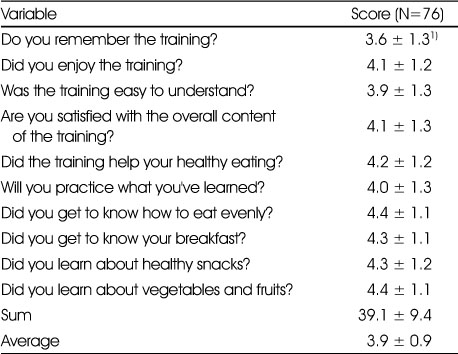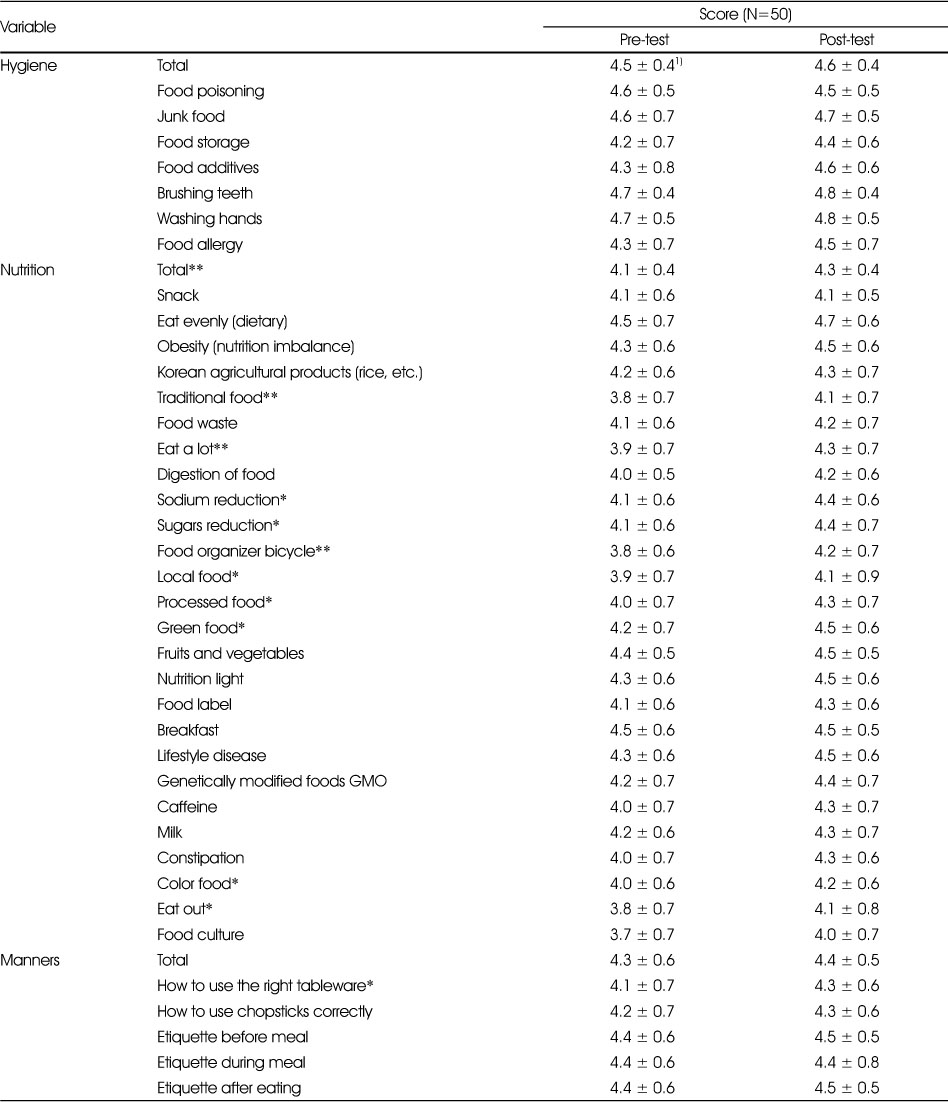Articles
- Page Path
- HOME > Korean J Community Nutr > Volume 24(6); 2019 > Article
-
Research Article
- Development and Application of an Education Program for Healthy Dietary Life for Elementary School Aftercare Class Children
-
Jung-Hyun Kim
 , Min Sook Kyung
, Min Sook Kyung , In-Young Park
, In-Young Park , Young Sim Park
, Young Sim Park
-
Korean Journal of Community Nutrition 2019;24(6):497-511.
DOI: https://doi.org/10.5720/kjcn.2019.24.6.497
Published online: December 31, 2019
1Department of Home Economics Education (Major of Food and Nutrition), PaiChai University, Daejeon, Korea, Professor.
2Graduate School of Yonsei University, Major of Food and Nutrition, Seoul, Korea, Graduate Student.
3Center for Children's Foodservice Management of Namdonggu, Incheon, Korea, Team Leader.
4Division of Food Science & Culinary Arts, Department of Food and Nutrition, Shinhan University, Uijeongbu, Korea, Professor.
- Corresponding author: Young Sim Park. Division of Food Science and Culinary Arts, Shinhan University, 95, Hoam-ro, Uijeongbu-si, Gyeonggi-do 11644, Korea. Tel: (031) 870-3504, Fax: (031) 870-3509, yspark529@naver.com
Copyright © 2019 The Korean Society of Community Nutrition
This is an Open-Access article distributed under the terms of the Creative Commons Attribution Non-Commercial License (http://creativecommons.org/licenses/by-nc/3.0/) which permits unrestricted non-commercial use, distribution, and reproduction in any medium, provided the original work is properly cited.
- 1,267 Views
- 6 Download
- 1 Crossref
Abstract
-
Objectives
- This study aimed to develop a school-centered healthy eating environment for children in elementary care classrooms and prevent incorrect eating habits and obesity through the development and application of standardized healthy eating habit-forming educational materials.
-
Methods
- Ten schools in eight districts of Gyeonggi-do and 400 students from 19 care classes were selected. Based on the developed educational materials, the program was applied to students once in two weeks. ‘Notices for Parents’ forms were also sent to the students' home to educate their parents. Pre and post-surveys were conducted to evaluate the effectiveness of the education. The pre-education, education, and aftercare were conducted from September 28 to September 31, 2016, from October 3 to November 30, 2016, and from December 5 to December 9, 2016, respectively.
-
Results
- The healthy eating program for elementary care classes was designed to develop a school-centered healthy eating environment and provide standardized educational material for healthy eating habits. Twelve educational topics were developed: 〈Eat Evenly〉, 〈Eat Breakfast〉, 〈Eat vegetables and Fruits〉, 〈Clean Body, Strong Body〉, 〈Healthy and Tasty Snacks〉, 〈Keep Healthy Weight〉, 〈Food that enters our body〉, 〈What is safe food?〉, 〈Food selection and Storage〉, 〈Our land, Our grain〉, 〈Enjoy Traditional Food〉, and 〈Food manners〉. Moreover, the materials were produced in four forms: for students, for after school caring teachers, for external specialists, and for parents. The effectiveness evaluation was conducted to confirm the application of the program. The average eating habits score was 3.3 ± 0.6, with no significant difference between before and after application. The score of overall satisfaction of the education was 3.9 ± 0.9. The most satisfying content was ‘Did you get to know how to eat evenly?’. Significant increases were observed in two contents for parents regarding their children's knowledge changes after the education: ‘Five nutrients needed for growing children’ and ‘Knowing sugar foods and sugar-containing foods’. On the other hand, their educational satisfaction was 3.6 ± 0.6, which was lower than the children's satisfaction. This might be because their education was conducted only through the ‘Notices for Parents’ form.
-
Conclusions
- In the long term, the healthy eating habit-formation education for lower elementary school children is expected to be beneficial. To prevent obesity and establish healthy eating habits of children, it is important to develop healthy eating education programs centered on elementary school aftercare classes, including the development of educational materials and an application system through connection with the home and community.
- 1. Korean Educational Development Institute. 2019 Guidelines for afterschool [internet]. Afterschool Portal System; 2018; cited 2019 Sep 10]. Available from: https://www.afterschool.go.kr/.
- 2. Ministry of Education. 2019 Operation guidelines for new semester afterschool. Sejong: Ministry of Education; 2018.
- 3. Kim HW. A suggestion for improvement of after-school. Ministry of Education; 2010 12.
- 4. Korea Health Promotion Institute. 2016 Annual report. Seoul: Korea Health Promotion Institute; 2017.
- 5. Ministry of Education. Sample data analytics results of physical growth, health screening of students [Internet]. Ministry of Education; 2016; cited 2019 Sep 10]. Available from: https:// www.moe.go.kr/main.do.
- 6. Kim HR, Lee SH, Choi JM, Oh YI. Children's obesity and underweight among low income families in Korea: Status, implications and policy options. Korea Institute for Health and Social Affairs; 2011 12. Report No. 2011-07.
- 7. Ministry of Education. 2014 School health examination sample survey. Sejong: Ministry of Education; 2015.
- 8. Korea Centers for Disease Control and Prevention. Korea health statistics 2017: Korea National Health and Nutrition Examination Survey [Internet]. Ministry of Health and Welfare; 2018; cited 2019 Sep 10]. Available from: https://knhanes.cdc.go.kr/knhanes/index.do.
- 9. Kim JH, Lee MH, Park OJ, Choi KS. A study on the development of the goals and contents system of healthy dietary education program for after-school care in lower grade in elementary school. Korean J Community Nutr 2019; 24(1): 24-37.ArticlePDF
- 10. Sung EJ. Establishment of roadmap for intervention study of adolescent obesity to prevent and control metabolic disease. Korea Centers for Disease Control & Prevention; 2016 04. Report No. 2015-ER-6402-00.
- 11. Lee YS, Lim HS, Chang NS, Ahn HS, Kim CI, Kim KN , et al. Nutrition through the life cycle. 4th ed. Paju: Gyomoonsa; 2017.
- 12. Yoo KH. Effects and problems of dining-out behavior on dietary habits. Seoul: National Assembly of Korea; 2004.
- 13. Ministry of Education. 2017 Sample data analytics results of physical growth, health screening of students [Internet]. Ministry of Education; 2018; cited 2019 Sep 10]. Available from: https:// www.moe.go.kr/main.do.
- 14. Yun JS, Lyu ES. Satisfaction and perception of nutrition education by elementary school students. J Korean Soc Food Sci Nutr 2012; 41(9): 1259-1264.Article
- 15. Kim HJ. Relationships among nutrient intake status, dietary balance and sugar-containing food intake of elementary school students in Daegu area [master's thesis]. Keimyung University; 2010.
- 16. Cho MY, Lee MJ, Lee YM. A study on utilization and consumption promotion of seafood in elementary school lunch program. Korean J Food Culture 2003; 18(2): 139-150.
- 17. Kyeon YK. Application of practical nutrition education program for the improvement of dietary habits and attitudes of elementary students [master's thesis]. Seoul National University of Education; 2006.
REFERENCES
Figure & Data
REFERENCES
Citations

- An Interactive Live and Online Cooking Program for Children in Vulnerable Families—An Exploratory Study
Jiyoung Park, Sein Hwang, Seolhyang Baek, Gill A. Ten Hoor
Healthcare.2022; 10(12): 2389. CrossRef

Fig. 1
Final training topics and overview
Student general
1) N (%), 2) Mean ± S.D.
Students' dietary habits
1) Reverse coding
*: p<0.05, **: p<0.001
2) Mean ± S.D.
Nutritional knowledge of students
**: p<.01, ***: p<0.001
1) Mean ± S.D.
Education satisfaction
1) Mean ± S.D.
Parent general
1) N (%)
Need for healthy dietary education
*: p<0.05, **: p<0.01
1) Mean ± S.D.
Students' healthy eating knowledge
*: p<0.05
1) Mean ± S.D.
Education satisfaction
1) Mean ± S.D.
1) N (%), 2) Mean ± S.D.
1) Reverse coding *: p<0.05, **: p<0.001 2) Mean ± S.D.
**: p<.01, ***: p<0.001 1) Mean ± S.D.
1) Mean ± S.D.
1) N (%)
*: p<0.05, **: p<0.01 1) Mean ± S.D.
*: p<0.05 1) Mean ± S.D.
1) Mean ± S.D.

 KSCN
KSCN










 Cite
Cite


